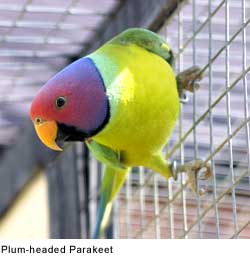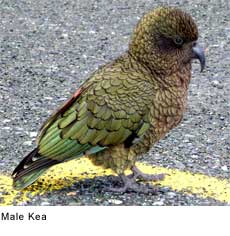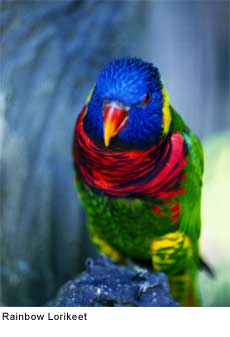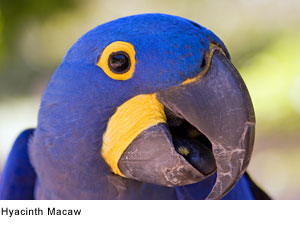
 Just the Facts: All members of the order have a characteristic curved beak shape with the upper mandible having slight mobility in the joint with the skull and a generally erect stance. All parrots are zygodactyl, having the four toes on each foot placed two at the front and two back. Just the Facts: All members of the order have a characteristic curved beak shape with the upper mandible having slight mobility in the joint with the skull and a generally erect stance. All parrots are zygodactyl, having the four toes on each foot placed two at the front and two back.
They Hate the Cold: Parrots can be found in most of the warm parts of
the world, including India, southeast Asia and west Africa, with one species, now extinct, in the United States (the Carolina Parakeet). By far the greatest number
of parrot species, however, come
from Australasia, South America and
Central America.
Parrots in Danger: The Convention on the International Trade in Endangered Species (CITES) has made the sale of all wild caught parrot species illegal; the highly endangered species are on on the CITES appendix 1 list and all of the other parrot species are on the CITES appendix 2 list of vulnerable species.
-----------------------------------------------------------------------------------------------------------------------------
Pet Parrots:
Beautiful Companions: Parrots are kept as pets, particularly conures, macaws, amazons, cockatoos, african grays, lovebirds, cockatiels, budgerigars and parakeets, because of their rich and varied coloration. Sometimes the wings of such birds are clipped, but many people keep flighted pet parrots. Some parrots species including cockatoos, amazon parrots, african gray parrots and the larger macaws have very long life-spans of up to 80 years.
 Long Live the Parrot! In 2004, Britain's Daily Mirror newspaper carried the story of a female macaw supposedly born in 1899, and subsequently a pet of Winston Churchill during the World War; the aged parrot, called Charlie, was reputed to curse the Nazis and Adolf Hitler Subsequent research strongly suggested that the parrot had never belonged to Winston Churchill, although Charlie's great age was not in question. Long Live the Parrot! In 2004, Britain's Daily Mirror newspaper carried the story of a female macaw supposedly born in 1899, and subsequently a pet of Winston Churchill during the World War; the aged parrot, called Charlie, was reputed to curse the Nazis and Adolf Hitler Subsequent research strongly suggested that the parrot had never belonged to Winston Churchill, although Charlie's great age was not in question.
Loved to Death: The popularity of parrots as pets has led to a thriving - often illegal - trade in the birds, and some species are now threatened with extinction. The scale of the problem can be appreciated in the Tony Silva case of 1996, in which a world-renowned parrot expert and former director at Tenerife's Loro Parque (Europe's largest parrot park) was jailed in the US for 82 months and fined $100,000 for smuggling Hyacinth macaws1. The case rocked conservationist and ornithological circles, leading to calls for greater protection and control over trade in the birds. Loro Parque has since become well known for parrot conservation work.
A Little Bird Told Me: Many species can imitate human speech or other sounds, and at least one researcher, Irene Pepperberg, has made controversial claims for the learning ability of one species; an African Grey Parrot named Alex has been trained
to use words to identify objects, describe them, count them, and even answer complex questions such as "How many red squares?" (with over 80% accuracy). Other scholars claim that parrots are only repeating words with no idea of their meanings
and point to Pepperberg's results as being nothing but an expression of
classical conditioning.
When Pet Parrots Escape... Escaped parrots can represent a threat to local ecosystems if they become established in the wild. This is now occurring in Spain,
in  Barcelona and Tenerife. Barcelona and Tenerife.
Several species, including Red-lored Parrots (Amazona autumnalis), Lilac-crowned Parrots (Amazona finschi), and Yellow-chevroned Parakeets (Brotogeris chiriri), have become well established in Southern California and another population of parrots lives surrounding Telegraph Hill in San Francisco.
A sizeable population of feral Rose-ringed Parakeets (Psittacula krameri) exists in and around London, England, and in various larger cities in the Netherlands, thought to have descended from escaped or released pets. The largest roost of these is thought to be in Esher, Surrey, numbering several thousand. There are also feral Monk Parakeets in many areas of the United States.

Origins of the Parrot:
 It's Gotta Be Gondwana: In general, an area which has, relative to other areas, It's Gotta Be Gondwana: In general, an area which has, relative to other areas,
a great concentration of different species within a particular family is likely to be the original ancestral home of that family. The diversity of Psittaciformes in South America and Australasia suggests that the order has a Gondwanian origin.
The parrot family's fossil record, however,
is sparse and their origin remains a matter of informed speculation rather than fact.
Cretaceous Creatures: The earliest known record of parrot-like birds dates to the late Cretaceous about 70 million years ago. A single 15 mm fragment from a lower bill found in Wyoming is similar to that of a modern lorikeet. It is not clear if this find should be classified as a parrot.
European Parrots? Europe is the site of more extensive records from the Eocene (58 to 36 million  years ago). Several fairly complete skeletons of parrot-like birds have been found in England and Germany. Some uncertainty remains, but on the whole it seems more likely that these are not true ancestors of the modern parrots, but are a related group which evolved in the Northern Hemisphere but have since died out. years ago). Several fairly complete skeletons of parrot-like birds have been found in England and Germany. Some uncertainty remains, but on the whole it seems more likely that these are not true ancestors of the modern parrots, but are a related group which evolved in the Northern Hemisphere but have since died out.
Gone South: The Southern Hemisphere does not have nearly as rich a fossil record for the period of interest as the Northern, and contains no known parrot-like remains earlier than the early to middle Miocene, around 20 million years ago. At this point, however, is found the first unambiguous parrot fossil (as opposed to a parrot-like one), an upper jaw which is indistinguishable from that of a modern white cockatoo.
-----------------------------------------------------------------------------------------------------------------------------
Parrot Species: The phylogeny of the parrots is still under investigation, and no
definite answers are available for sections of the phylogeny. The
classification as  presented reflects the current status, and is subject
to change when new studies resolve some of the open questions. For that
reason, this classification should be treated with care. presented reflects the current status, and is subject
to change when new studies resolve some of the open questions. For that
reason, this classification should be treated with care.
Some authorities regard the lorikeets as a third family rather than part of the Psittacidae, or lump the cockatoos into one giant family. The majority view, however, is that the Cacatuidae are quite distinct, having a movable head crest, different arrangement of the carotid arteries, a gall bladder, different skull bones, and not having the Dyck texture feather composition which, in the Psittacidae, scatters light in such a way as to produce the vibrant colours of so many parrots. This classification is
used here:
- Family Cacatuidae: cockatoos, 21 species in 6 genera
- Family Psittacidae: true parrots, about 332 species
- Subfamily Loriinae: 12 genera with 53 species of lorikeets and lories, centered in New Guinea, spreading to Australia, Indonesia, and the islands of the south Pacific. (Sometimes classed as a full family and thus termed Loriidae.)
- Subfamily Nestorinae: 3 species in 1 genus, the Kea and Kākā of New Zealand and the extinct Norfolk Island Kaka
- Subfamily Strigopinae: Kakapo
- Subfamily Micropsittinae: 6 species of pygmy parrot, all in a single genus
- Subfamily Psittacinae
- Tribe Psittacini: Afrotropical parrots, 12 species in 3 genera
- Tribe Psittrichadini: Pesquet's Parrot
- Tribe Cyclopsittacini: fig parrots, 6 species in 3 genera, all from New Guinea or nearby
- Tribe Polytelini: three genera.
- Tribe Psittaculini: Paleotropic psittaculine parrots, 66 species in 12 genera, distributed from India to Australasia
- Subfamily Platycercinae: 28 species in 11 genera.
- Tribe Platycercini: 18 species in 8 genera, including the rosellas.
- Tribe Melopsittacini: one genus with one species, the Budgerigar.
- Tribe Neophemini: two small genera of parrots.
- Tribe Pezoporini: one genus of parrots with two species.
- Subfamily Arinae: Neotropical parrots, 148 species in 30 genera

All text is available under the terms
of the GNU Free Documentation License |